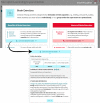User-Centered Design and Evaluation of a Web-Based Decision Aid for Older Adults Living With Mild Cognitive Impairment and Their Health Care Providers: Mixed Methods Study
- PMID: 32442151
- PMCID: PMC7468645
- DOI: 10.2196/17406
User-Centered Design and Evaluation of a Web-Based Decision Aid for Older Adults Living With Mild Cognitive Impairment and Their Health Care Providers: Mixed Methods Study
Abstract
Background: Mild cognitive impairment (MCI) is often considered a transitional state between normal and pathologic (eg, dementia) cognitive aging. Although its prognosis varies largely, the diagnosis carries the risk of causing uncertainty and overtreatment of older adults with MCI who may never progress to dementia. Decision aids help people become better informed and more involved in decision making by providing evidence-based information about options and possible outcomes and by assisting them in clarifying their personal values in relation to the decision to be made.
Objective: This study aimed to incorporate features that best support values clarification and adjust the level of detail of a web-based decision aid for individuals with MCI.
Methods: We conducted a rapid review to identify options to maintain or improve cognitive functions in individuals with MCI. The evidence was structured into a novel web-based decision aid designed in collaboration with digital specialists and graphic designers. Qualitative and user-centered evaluations were used to draw on users' knowledge, clarify values, and inform potential adoption in routine clinical practice. We invited clinicians, older adults with MCI, and their caregivers to evaluate the decision aid in 6 consecutive rounds, with new participants in each round. Quantitative data were collected using the Values Clarity and Informed subscales of the Decisional Conflict Scale, the System Usability Scale, the Ottawa Acceptability questionnaire, and a 5-point satisfaction rating scale. We verified their comprehension using a teach-back method and recorded usability issues. We recorded the audio and computer screen during the session. An inductive thematic qualitative analysis approach was used to identify and describe the issues that arose. After each round, an expert panel met to prioritize and find solutions to mitigate the issues. An integrated analysis was conducted to confirm our choices.
Results: A total of 7 clinicians (social workers, nurses, family physicians, psychologists) and 12 older (≥60 years) community-dwelling individuals with MCI, half of them women, with education levels going from none to university diploma, were recruited and completed testing. The thematic analysis revealed 3 major issues. First, the user should be guided through the decision-making process by tailoring the presentation of options to users' priorities using the values clarification exercise. Second, its content should be simple, but not simplistic, notably by using information layering, plain language, and pictograms. Third, the interface should be intuitive and user friendly, utilize pop-up windows and information tips, avoid drop-down menus, and limit the need to scroll down. The quantitative assessments corroborated the qualitative findings.
Conclusions: This project resulted in a promising web-based decision aid that can support decision making for MCI intervention, based on the personal values and preferences of the users. Further ongoing research will allow its implementation to be tested in clinical settings.
Keywords: aging; decision aid; decision support technique; elderly; mild cognitive impairment.
©Laura-Mihaela Bogza, Cassandra Patry-Lebeau, Elina Farmanova, Holly O Witteman, Jacobi Elliott, Paul Stolee, Carol Hudon, Anik M C Giguere. Originally published in the Journal of Medical Internet Research (http://www.jmir.org), 19.08.2020.
Conflict of interest statement
Conflicts of Interest: None declared.
Figures








References
-
- Petersen RC, Lopez O, Armstrong MJ, Getchius TS, Ganguli M, Gloss D, Gronseth GS, Marson D, Pringsheim T, Day GS, Sager M, Stevens J, Rae-Grant A. Practice guideline update summary: mild cognitive impairment: report of the guideline development, dissemination, and implementation subcommittee of the American academy of neurology. Neurology. 2018 Jan 16;90(3):126–35. doi: 10.1212/WNL.0000000000004826. http://europepmc.org/abstract/MED/29282327 - DOI - PMC - PubMed
-
- Nagamatsu LS, Handy TC, Hsu CL, Voss M, Liu-Ambrose T. Resistance training promotes cognitive and functional brain plasticity in seniors with probable mild cognitive impairment. Arch Intern Med. 2012 Apr 23;172(8):666–8. doi: 10.1001/archinternmed.2012.379. http://europepmc.org/abstract/MED/22529236 - DOI - PMC - PubMed
-
- Kaduszkiewicz H, Eisele M, Wiese B, Prokein J, Luppa M, Luck T, Jessen F, Bickel H, Mösch E, Pentzek M, Fuchs A, Eifflaender-Gorfer S, Weyerer S, König HH, Brettschneider C, van den Bussche H, Maier W, Scherer M, Riedel-Heller SG, Study on Aging‚ Cognition‚Dementia in Primary Care Patients (AgeCoDe) Study Group Prognosis of mild cognitive impairment in general practice: results of the German AgeCoDe study. Ann Fam Med. 2014;12(2):158–65. doi: 10.1370/afm.1596. http://www.annfammed.org/cgi/pmidlookup?view=long&pmid=24615312 - DOI - PMC - PubMed
-
- Joseph-Williams N, Newcombe R, Politi M, Durand M, Sivell S, Stacey D, O'Connor A, Volk RJ, Edwards A, Bennett C, Pignone M, Thomson R, Elwyn G. Toward minimum standards for certifying patient decision AIDS: a modified delphi consensus process. Med Decis Making. 2014 Aug;34(6):699–710. doi: 10.1177/0272989X13501721. - DOI - PubMed
Publication types
MeSH terms
Grants and funding
LinkOut - more resources
Full Text Sources
Miscellaneous

